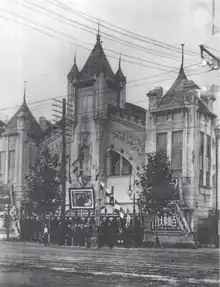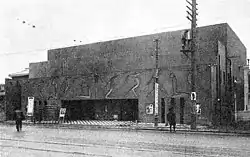 Aoikan Theatre 1913 | |
 Aoikan Theatre 1924 | |
| Address | Minato-ku Akasaka, Tokyo Japan |
|---|---|
| Coordinates | 35°40′12″N 139°44′24″E / 35.67000°N 139.74000°E |
| Construction | |
| Opened | July 1913 |
| Reopened | 1924 |
| Demolished | 1931 |
The Aoikan (葵館) was a movie theater in the Tameike section of Akasaka in Tokyo, Japan. It existed since the mid–1910s as a high-class foreign film theater, featuring benshi such as Musei Tokugawa.
After the Great Kanto earthquake, it re-opened in October 1924 with a new, modern design created by prominent avant-garde artists. Seisaku Yoshikawa was in charge of architectural design, Yasuji Ogishima did the sculptural reliefs on the front of the building, and Tomoyoshi Murayama designed the interior.[1][2] Murayama also did the cover illustrations for the theater's pamphlets in the first few years.[3]
Film scholars such as Kenji Iwamoto have noted this theater's significance in Japanese cinematic modernism of the 1920s and 1930s.[4]
References
- ↑ Kikuchi (January 13, 2010). "Aoikan" (in Japanese). Shūzōko ichigōkan. Retrieved 5 April 2010.
- ↑ "Aoikan rerīfu no chōkokuka Ogishima Yasuji" (in Japanese). Bunriha kenchiku hakubutsukan. Retrieved 5 April 2010.
- ↑ "Aoikan to Aoi wīkurī" (in Japanese). Aoyama biyori. March 12, 2006. Retrieved 5 April 2010.
- ↑ Kenji Iwamoto, ed. (1991). Nihon eiga to modanizumu, 1920-1930 (in Japanese). Riburo Pōto. ISBN 4-8457-0616-4.
External links
- Akasaka Aoikan The Aoikan pamphlet Aoi Weekly (in Japanese)
This article is issued from Wikipedia. The text is licensed under Creative Commons - Attribution - Sharealike. Additional terms may apply for the media files.